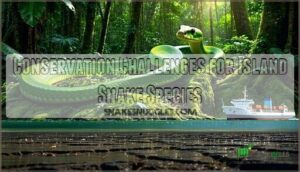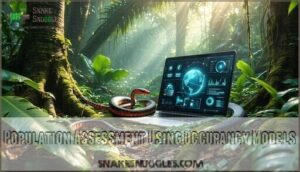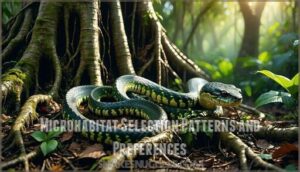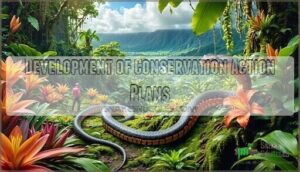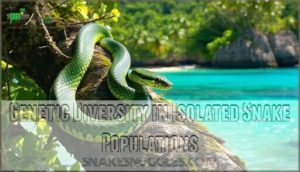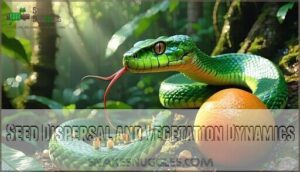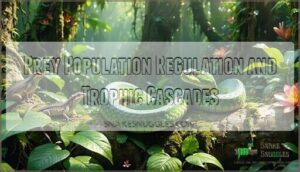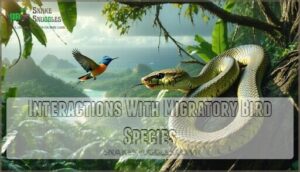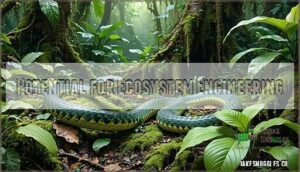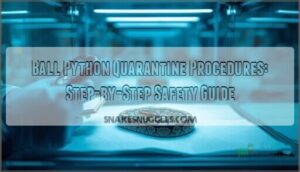This site is supported by our readers. We may earn a commission, at no cost to you, if you purchase through links.
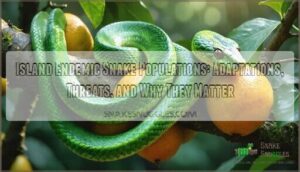
They adapt in quirky ways, like eating only one type of prey or developing odd colors to match the local plants.
There’s a catch, though: with so few neighbors, genetic diversity runs low, making these snakes more vulnerable to threats like invasive predators or a sudden storm.
They’re nature’s reminder that living in paradise isn’t all sun and coconuts—survival takes a clever twist, and these snakes are a prime example of clever adaptations.
Stick around, and you’ll see how their stories shape the whole island ecosystem in surprising ways.
Table Of Contents
- Key Takeaways
- Unique Characteristics of Island Endemic Snake Populations
- Conservation Challenges for Island Snake Species
- Case Study: San Andres Red Snake
- Genetic Diversity in Isolated Snake Populations
- Ecological Impacts of Island Snake Populations
- Frequently Asked Questions (FAQs)
- What snakes live on Snake Island?
- Why do snakes live on Snake Island?
- What is Snake Island?
- Why is Snake Island important?
- Can You Survive on Snake Island?
- Why does Snake Island have a golden lancehead snake?
- Which island has the most snakes?
- Which Caribbean islands have snakes?
- Is there a lot of snakes in Snake Island?
- How many snakes are on Snake Island in total?
- Conclusion
Key Takeaways
- You’ll find that island endemic snake populations are true specialists, adapting to their environments in quirky ways, but they’re also vulnerable due to low genetic diversity, making them more susceptible to threats like invasive predators or environmental changes.
- These snakes play a crucial role in their ecosystems, controlling prey populations, dispersing seeds, and maintaining balance, so it’s up to you to help conserve them and ensure their survival.
- You’ll discover that conservation efforts for island endemic snake populations are complex, involving habitat restoration, invasive species control, and community engagement, and it’s essential to address the unique challenges they face, like climate change and human persecution.
- By understanding the importance of island endemic snake populations and the challenges they face, you can contribute to their conservation, and it’s not just about saving the snakes – it’s about preserving entire ecosystems and the delicate balance of nature.
Unique Characteristics of Island Endemic Snake Populations
You’ll spot some wild surprises when you look at snakes that only live on islands—think giants, tiny guys, and snakes with super-specialized venom.
Nature works overtime in these places, turning survival into a science project with a sense of humor and a few curveballs thrown in.
Evolutionary Adaptations to Isolated Environments
On islands, snakes rewrite the rulebook—literally!
On islands, snakes become evolution’s wildcards, breaking all the rules and inventing new tricks for survival.
Thanks to isolation, you’ll spot island endemic snakes flaunting gigantism or dwarfism, adjusting their scale patterns, and even fine-tuning their venom specialization.
Watch their hunting strategies evolve on the fly and see microhabitat use turn into an art.
It’s peak snake evolution islands style—where snake adaptation islands and isolated snake populations reveal nature’s endless taste for surprise and survival.
Limited Genetic Diversity and Inbreeding Risks
You’ve seen amazing adaptations, but isolation has a flip side. Island snakes face risks because of limited gene pools. Think of it as a family reunion where everyone is related.
This leads to increased inbreeding depression. Population bottlenecks and founder effects act like genetic speed bumps.
It’s like:
- Losing your keys.
- Forgetting your wallet.
- Spilling coffee.
- Realizing your phone is dead.
Genetic drift and low mutation rates add to the challenge. Habitat fragmentation exacerbates these issues for snake populations.
Conservation genetics helps.
Specialized Prey Relationships and Feeding Habits
You’ll find island snakes have unique prey relationships, with specialized diets like the golden lancehead’s bird-focused diet, driven by prey availability and venom evolution, showcasing prey specialization and adapted feeding strategies.
This is especially true where island area is smaller, which correlates with more complex venom.
Ecological Roles Within Island Ecosystems
You might think snakes are just predators but they’re essential. They’ve key ecological roles in island ecosystems. They aren’t just eating machines.
They’re nature’s pest controllers. They’re seed dispersers and food for other critters. They maintain balance. They influence invertebrate communities.
They impact seed dispersal and trophic cascades. They’ve bird interactions. They’re ecosystem engineers!
- They help control pests.
- They disperse seeds.
- They regulate prey.
- They shape ecosystems.
Vulnerability to Environmental Changes and Disturbances
Now that you know how important island snakes are in their ecosystems, let’s look at the storms they face.
Living on an island isn’t just hammocks and sunshine. If you’re a member of island endemic snake populations, you’re dodging threats on every front:
- Climate Impacts are turning up the heat and making water scarce.
- Invasive Species act like uninvited guests, stealing food and spreading chaos.
- Habitat Fragmentation breaks up home turf into confusing pieces.
- Pollution brings toxins to every corner.
- Diseases sweep through fast, especially with little escape.
These hurdles test the limits of endemic snake diversity and island snake conservation.
Conservation Challenges for Island Snake Species
You’ll find that island snakes face a unique set of conservation headaches, from shrinking habitats to sneaky predators that don’t play by the local rules.
Saving these reptiles isn’t just about keeping snakes around—it’s about protecting entire ecosystems, even if you’d rather not meet one in your shoes, which involves understanding the importance of conservation and the role of island snakes.
Habitat Loss Due to Human Development
You’ve just learned how unique island endemic snake populations can be.
Now picture them trying to outmaneuver bulldozers and selfie sticks.
Habitat loss isn’t just a buzzword—tourism impacts, agricultural expansion, and urban sprawl squeeze these reptiles out of their homes.
Deforestation effects go beyond tree loss, setting off changes that ripple through food webs.
Smart development planning can make a real difference for snake conservation.
Without careful choices, those slithery locals could end up as rare as a sunburn-free tourist on a sandy beach, facing habitat loss and deforestation effects, which are critical concerns for snake conservation.
Threats From Introduced Predators and Competitors
Just when you think habitat loss is the only problem, along come the introduced predators and invasive species.
It’s like throwing a hungry cat into a room full of mice—chaos follows.
These newcomers create all sorts of conservation challenges for island snake populations, stacking up headaches for scientists:
- Predation pressure from new species
- Resource competition with aggressive invaders
- Wild ecosystem disruption
- Sneaky diseases hitching a ride
Conservation strategies must consider these threats to keep island snakes safe.
Climate Change Impacts on Island Habitats
While introduced predators create immediate threats, climate change impacts are reshaping island snake habitats permanently.
Sea level rise threatens low-lying coastal areas where many endemic species live.
Temperature shifts force snakes to seek new territories, but islands offer limited escape routes.
Extreme weather events like hurricanes destroy critical nesting sites and food sources.
Habitat degradation from flooding and saltwater intrusion makes once-suitable areas uninhabitable, and these changes alter species distribution patterns, pushing vulnerable populations toward extinction cliffs they can’t retreat from.
Human Persecution and Misconceptions About Snakes
Snake fear runs deep in island communities, where cultural beliefs often paint these reptiles as dangerous threats.
This human persecution creates serious obstacles for snake conservation efforts.
Here’s what’s really happening:
- Locals killing snakes on sight due to misconceptions about aggression
- Eradication efforts targeting beneficial species alongside harmful ones
- Human-snake conflict escalating when people encounter unfamiliar endemic species
Conservation education can transform these humansnake interactions through targeted snake awareness programs that address cultural myths while promoting coexistence.
Case Study: San Andres Red Snake
You’ll find the San Andres Red Snake fascinating as a textbook example of island endemism gone critical.
This tiny serpent, found only on Colombia’s San Andres Island, represents what happens when evolution meets isolation—and what we risk losing when conservation efforts fall short, highlighting the importance of preserving unique species like the San Andres Red Snake as a result of evolution.
Endemic Status and Habitat on San Andres Island
San Andres Island’s endemic red snake faces a unique conservation challenge.
This critically endangered species exists nowhere else on Earth, making Island Endemism a critical factor in its survival story.
You’ll find this endemic reptile species thriving in the island’s lush forests and coastal areas, where Habitat Specificity determines its fate.
The San Andres Red Snake’s Conservation Status reflects broader threats to island biodiversity snakes worldwide.
Human development pressures these fragile island ecosystems, while Community Engagement efforts aim to bridge the gap between residents and wildlife.
Understanding this species’ restricted range helps scientists develop targeted Threat Analysis strategies for protecting island snake species in similar situations.
The island’s snake populations mirror the Caribbean Islands’ endemic habitats, making conservation efforts essential.
Population Assessment Using Occupancy Models
You’re evaluating island endemic snake populations using occupancy models.
These models consider:
- Detection probability
- Habitat covariates
- Model validation
They help estimate population sizes, like the San Andres Red Snake, by accounting for detection probability and habitat characteristics.
Researchers often utilize specialized model software for this purpose, which is a key aspect of model validation.
Microhabitat Selection Patterns and Preferences
You’ll discover island snake species prioritize microhabitat selection, considering habitat partitioning, resource availability, and predation avoidance, to thrive in their ecosystem.
Thermal regulation and competition influence also playing a role, as seen in island endemic snake populations and their unique snake ecology islands characteristics, with habitat partitioning being a key factor.
Development of Conservation Action Plans
You’re key to saving the San Andres Red Snake.
Develop conservation action plans, focusing on habitat restoration, invasive control, and community engagement.
Implement policies, monitor programs, and prioritize biodiversity conservation to protect threatened island snakes and enhance their conservation status.
Genetic Diversity in Isolated Snake Populations
You’re about to explore the genetic diversity of isolated snake populations, where you’ll discover how these snakes adapt to their environments.
As you learn about genetic diversity, you’ll see how it affects the long-term survival of these unique island species.
And what conservation efforts are in place to protect them.
Shedao Pit-viper as a Model Species
You’re exploring the Shedao pit-viper, a genetic goldmine. This species showcases Venom Evolution and Island Gigantism, with unique adaptations.
Conservation Genetics and Adaptive Radiation play a role in its survival, highlighting Habitat Specificity within island ecosystems, affecting snake adaptation and genetic diversity.
You can even find Shedao pit-viper products.
Population Bottlenecks and Founder Effects
Island snakes, like castaways, face tough genetic odds.
Population bottlenecks shrink the gene pool.
Bottleneck causes and founder effects create limited gene pools.
Imagine starting over with a tiny group.
Founder consequences include increased genetic drift.
It’s like a genetic lottery.
Some traits dominate others vanish.
Inbreeding depression rises.
Extinction risk increases.
The snakes may suffer from severe population decline.
- Reduced adaptability
- Increased disease susceptibility
- Higher rates of birth defects
- Lower fertility
- Decreased survival rates
Adaptive Radiation in Island Environments
You’ll find island snakes undergoing adaptive radiation, evolving to fill various ecological niches through niche partitioning and morphological diversification.
Driven by environmental pressures and the founder effect, showcasing unique snake adaptation islands within island ecosystems.
Implications for Long-term Species Viability
You’ve seen how adaptive radiation shapes snakes. But what does it mean for their future? For snake biogeography islands, long-term survival can be a nail-biter.
- Genetic bottlenecks limit adaptability.
- Small populations are vulnerable to inbreeding.
- Habitat fragmentation further isolates groups.
- Climate change poses unique challenges for island species.
These factors increase extinction risk. Limited snake genetics islands make them vulnerable. Understanding dominant and recessive traits is essential for conservation efforts.
It’s like betting on a horse race with only one horse. To boost snake adaptation islands, we need serious conservation planning. Think of it as snake speciation islands meets "Extreme Makeover: Habitat Edition".
Genetic Management Strategies for Conservation
When populations face extinction, genetic management becomes your lifeline.
You’ll use genetic rescue through assisted migration, introducing new individuals to boost gene flow.
Ex situ breeding programs preserve genetic diversity while minimizing hybridization risks.
| Strategy | Method | Benefit |
|---|---|---|
| Genetic Rescue | Introduce new individuals | Increases genetic diversity |
| Ex Situ Breeding | Captive breeding programs | Preserves genetic material |
| Assisted Migration | Relocate breeding individuals | Enhances gene flow |
Ecological Impacts of Island Snake Populations
You’ll discover that island snakes aren’t just survivors—they’re ecosystem architects. These isolated populations create ripple effects throughout their island homes, from controlling prey numbers to accidentally moving seeds around.
Seed Dispersal and Vegetation Dynamics
Looking at genetics and diversity tells only part of the story.
When you watch snakes hunt, you’re witnessing nature’s botanical couriers in action. Snake seed dispersal happens when these reptiles eat fruit-loving prey, then travel across island ecosystems carrying seeds in their guts.
This dispersal mechanism creates surprising vegetation impact as plants colonize new areas.
Through co-evolution, island reptile fauna and plant communities develop intricate relationships that shape biodiversity conservation efforts.
This process highlights the importance of overwater dispersal mechanisms in island ecosystems.
Prey Population Regulation and Trophic Cascades
After snakes help disperse seeds across island vegetation, they tackle another essential job: controlling prey populations.
Island snakes act as nature’s regulators, creating trophic cascades that ripple through entire ecosystems. Their predator influence shapes community structure in ways that surprise researchers.
Here’s how these keystone species maintain ecosystem balance:
- Direct prey regulation – They control rodent and lizard populations through consistent predation pressure
- Indirect plant protection – By reducing herbivore numbers, they allow vegetation to recover and thrive
- Trophic dynamics shift – Their hunting creates cascading effects that benefit multiple species levels
- Community structure stability – Island reptile fauna helps maintain balanced predator-prey dynamics across habitats
These ecological architects prove that even small snake populations can have outsized impacts on their island homes.
Interactions With Migratory Bird Species
Most island snakes depend heavily on migratory birds as their primary food source, creating fascinating predator-prey dynamics.
The golden lancehead’s venom is five times more potent than mainland relatives – an adaptation driven by co-evolutionary processes with avian prey.
When bird migration impacts reduce stopover numbers, snake populations crash dramatically, affecting entire island ecosystems and influencing everything from snake diet patterns to avian conservation strategies.
These ecological impacts demonstrate how migratory birds and island snakes have evolved together in an intricate dance.
Influence on Invertebrate Communities
Beyond their interactions with birds, you’ll discover that island snakes dramatically reshape invertebrate communities through predation effects and trophic dynamics.
These reptiles serve as nature’s insect control specialists, maintaining ecosystem balance across their territories.
Here’s how snakes influence invertebrate populations:
- Direct predation – Many species actively hunt beetles, spiders, and other arthropods
- Habitat modification – Snake movements create microhabitat changes affecting invertebrate distribution
- Prey competition – Snakes compete with invertebrates for shared food sources
- Cascading effects – Removing vertebrate prey shifts snake focus to invertebrate communities
This predator-prey dynamic creates complex community structure changes that ripple through ecological niches, ultimately supporting ecological balance in island ecosystems.
Potential for Ecosystem Engineering
Imagine snakes wearing hard hats—these critters are true ecosystem engineers in island ecosystems.
Through Habitat Modification, they shape Community Structure, guide Nutrient Cycling, and set Disturbance Regimes that ripple through every ecological niche.
Their role as Keystone Species makes predator–prey dynamics hum like a well-tuned engine.
| Engineering Impact | Island Example |
|---|---|
| Nutrient Cycling | Ambergris Cay |
| Habitat Modification | Shedao Island |
| Disturbance Regimes | Aruba Rattlesnake |
| Community Structure | San Andres Red Snake |
Frequently Asked Questions (FAQs)
What snakes live on Snake Island?
You’ll find the golden lancehead, a venomous and endangered species, inhabiting Snake Island, off Brazil’s coast, with its potent venom and unique adaptations.
Why do snakes live on Snake Island?
You’ll discover snakes live on Snake Island due to its unique ecosystem, providing them with a suitable habitat, abundant prey, and isolation, allowing them to thrive and adapt.
What is Snake Island?
You’re likely referring to Ilha da Queimada Grande, a Brazilian island, also known as Snake Island, due to its dense population of venomous golden lancehead vipers.
Why is Snake Island important?
You’ll uncover Snake Island’s importance as a unique ecosystem, home to the golden lancehead, a venomous snake, showcasing evolutionary adaptations and conservation challenges in a fragile, isolated environment naturally.
Can You Survive on Snake Island?
You can’t survive on Snake Island due to its dense golden lancehead population, making it one of the deadliest places on earth, with no human inhabitants allowed.
Why does Snake Island have a golden lancehead snake?
You’ll find the golden lancehead on Snake Island due to its unique adaptation, potent venom, and isolation, making it a fascinating example of evolutionary specialization in a restricted environment naturally.
Which island has the most snakes?
You’ll discover that Ilha da Queimada Grande, or Snake Island, has the highest concentration of venomous golden lancehead snakes, making it a unique ecosystem with a notable snake population.
Which Caribbean islands have snakes?
You’ll encounter snakes on many Caribbean islands, including the Bahamas, Jamaica, and Hispaniola, which are home to diverse species, such as boas, vipers, and coral snakes, totaling 46 species.
Is there a lot of snakes in Snake Island?
You’ll likely see many golden lancehead vipers on Snake Island, as it’s their only known habitat, making this island a unique spot for these venomous snakes to thrive.
How many snakes are on Snake Island in total?
You’ll find thousands of golden lancehead vipers on Snake Island, a staggering number, making it a unique ecosystem with a high concentration of this venomous species in a small area.
Conclusion
You’re now aware that island endemic snake populations are delicate, with low genetic diversity.
It’s a "tropical trap" – they’re specialists, but vulnerable.
These island endemic snake populations play a vital role, and it’s up to you to help conserve them, ensuring their survival in paradise isn’t just a myth.
- https://www.iucn.org/theme/species/our-work/species-conservation
- https://www.nationalgeographic.org/encyclopedia/ecosystem/
- https://colombia.travel/en/san-andres-island
- https://scholar.google.com/scholar_lookup?journal=Mem%C3%B3rias%20Instituto%20Butantan&title=Contribui%C3%A7%C3%A3o%20para%20o%20Conhecimento%20dos%20Of%C3%ADdeos%20do%20Brasil.%20A.%20Parte%20I.%20Descri%C3%A7%C3%A3o%20de%20uma%20Nova%20Esp%C3%A9cie&author=A.%20Amaral&volume=1&publication_year=1921&pages=19-37&
- https://doi.org/10.11646/zootaxa.4097.4.4

